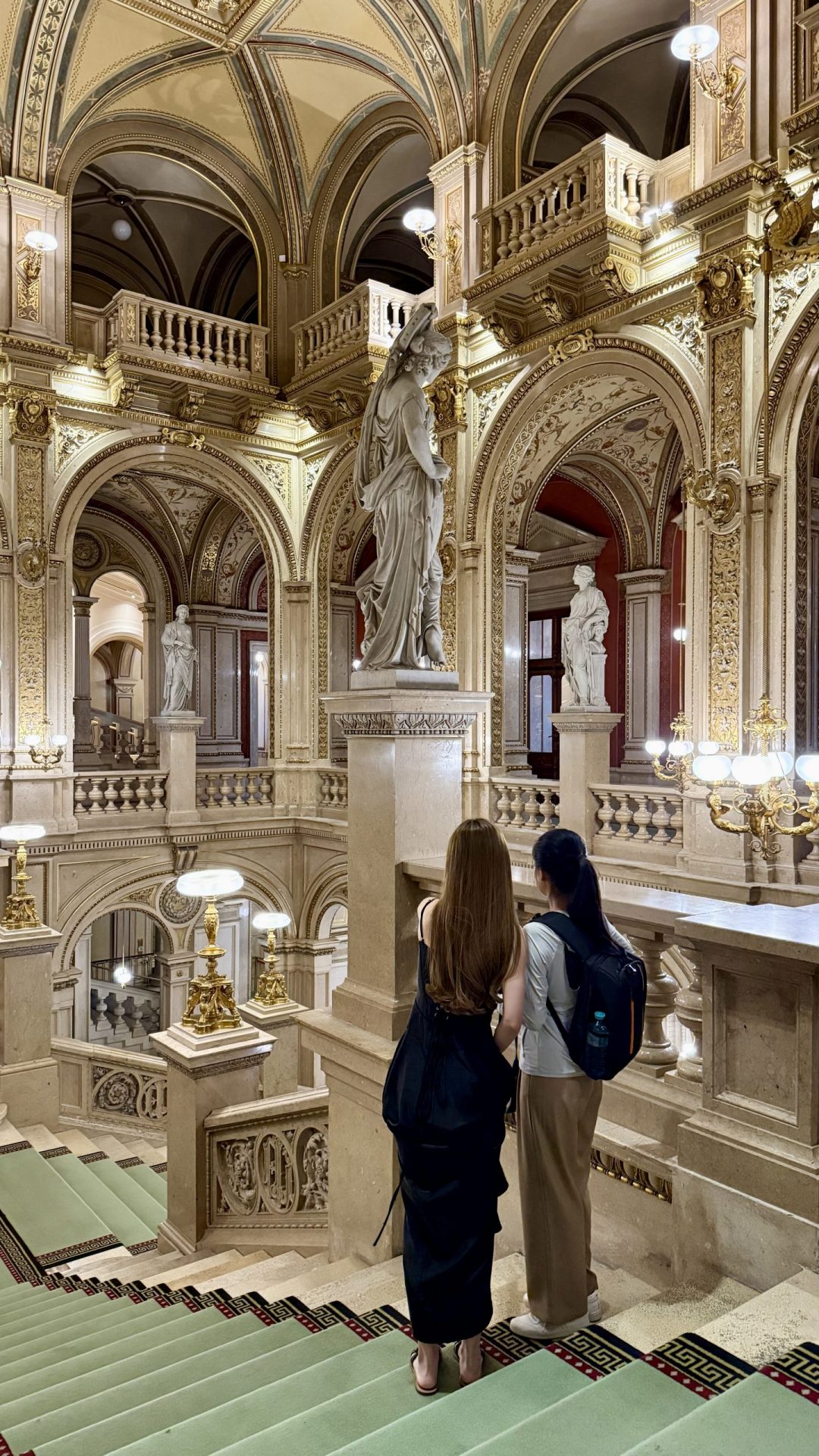Experience Travel Insights
From Ashes to Arias: The Unforgettable Story of the Vienna State Opera House
by Long Lin-Maurer • September 24, 2025

The Vienna State Opera House: More Than a Stage, It’s the Soul of a City
To stand before the Vienna State Opera House is to stand before the very heart of Vienna. It is not merely a magnificent building on the city’s grand Ringstrasse boulevard; it is a living, breathing institution, a repository of history, and the ultimate symbol of Austria’s cultural resilience. For the Viennese, the Staatsoper is more than a venue for world-class performances—it is a cornerstone of their identity. This iconic Vienna Opera House is a place where the city’s past, present, and future converge in a symphony of art, architecture, and enduring passion. Understanding this institution is to begin to understand the complex, sophisticated soul of Vienna itself.
Come and experience travel!
Personally designed, seamlessly delivered – your journey, our expertise!
We are a boutique travel agency and consultancy specializing in Hub & Spoke Tours across Central Europe, the Benelux and the Dolomites.
The Contentious Birth of the Vienna Opera House
The story of the State Opera Vienna begins not with a triumphant flourish, but with a public relations catastrophe. As the first major public building erected on the newly created Ringstrasse in the 1860s, it was intended to be the glittering jewel in the Habsburg Empire’s crown. The architects, August Sicard von Sicardsburg and Eduard van der Nüll, envisioned a monumental neo-Renaissance architectural masterpiece. However, the project was immediately beset by criticism.
The Viennese, ever discerning and never shy with their opinions, decried the design. A critical miscalculation in the planning of the Ringstrasse itself meant the street level was raised by a meter after the Opera’s foundations were laid, causing the building to appear sunken and less imposing than intended. The press mockingly nicknamed it the “sunken chest.” Even the Emperor, in a moment of unguarded candor, was reported to have commented on its underwhelming stature.
For the highly sensitive architect Eduard van der Nüll, this public and imperial disapproval was unbearable. He took his own life in 1868, just before the building’s completion. A mere ten weeks later, his creative partner, August Sicard von Sicardsburg, died of a heart attack—a “broken heart,” as the Viennese legend goes. When the Vienna Opera finally opened in May 1869 with a premiere of Mozart’s Don Giovanni, its magnificent interior could not entirely erase the tragedy of its conception.
A Phoenix from the Ashes: Rebuilding the State Opera Vienna
The Viennese State Opera that stands today is a powerful testament to survival. On March 12, 1945, in the final, desperate months of World War II, an Allied bombing raid went astray. The Opera was engulfed in a conflagration that raged for two days, gutting the auditorium and stage. The heart of Vienna had been torn out.
Yet, crucial parts of the building miraculously survived. The grand main façade, the majestic central staircase, the Schwind Foyer with its murals, and the elegant Tea Salon were all spared. In the immediate post-war period, the decision of what to do with the ruined Opera became a national debate. The question was not if the Vienna State Opera House should be rebuilt, but how.
The ultimate decision was a masterful blend of reverence and progress. The preserved historical sections were meticulously restored, while the destroyed auditorium and stage were rebuilt using state-of-the-art 1950s technology and acoustics. When the doors reopened on November 5, 1955, with a performance of Beethoven’s Fidelio—an opera about freedom from tyranny—it was a deeply symbolic moment. The Wiener Staatsoper was no longer just a Habsburg relic; it was the definitive symbol of the Second Austrian Republic.
Come and experience travel!
We design bespoke travel experiences with a perfect balance of cultural depth, efficiency and comfort.
Specializing in seamless hub-and-spoke journeys, we create well-paced, immersive itineraries tailored to your interests.
The Unseen Excellence of the Wiener Staatsoper
What many visitors who marvel at the gilded interiors fail to grasp is the sheer scale and complexity of the operation humming just beyond the curtain. The Vienna State Opera is one of the world’s last and greatest repertory theaters. Unlike the stagione system, the Staatsoper stages a different opera or ballet almost every single night of its ten-month season.
This Herculean feat requires a logistical ballet as intricate as any performed on stage. It involves a permanent ensemble of singers, the world-renowned Vienna Philharmonic (drawn from the ranks of the Opera orchestra), a chorus, a ballet corps, and over a thousand technicians and staff. The backstage area is a city unto itself. This demanding system means the Vienna opera schedule is packed, offering incredible dynamism. To mount Aida one night and Wozzeck the next is an organizational marvel. Beyond the regular performances, the building also transforms annually to host the world-famous Vienna Opera Ball, a highlight of the Viennese social calendar.
Tradition Meets Innovation at the Vienna Opera
While steeped in history, the Vienna State Opera is not a museum. This is perhaps best exemplified by the tradition of the Stehplätze, or standing room tickets. For just a few euros, anyone can gain entry to watch a world-class performance. This democratic tradition of affordable standing room tickets ensures that the opera remains accessible to all, fostering a deep connection between the institution and the city’s populace.
In the 21st century, the Viennese State Opera has continued to evolve. Every seat is now equipped with a small screen providing subtitles in multiple languages, making the art form accessible to an international audience. The “Opera Live at Home” program streams performances in high definition, bringing the cultural heartbeat of the State Opera Vienna to a worldwide audience. The programming itself is a careful juxtaposition of beloved classics, rediscovered rarities, and bold contemporary works, ensuring the art form remains relevant.
Experiencing the Vienna State Opera House: A Visitor’s Guide
To truly appreciate the Wiener Staatsoper, one must experience its multifaceted identity. Many opt for one of the excellent guided tours offered daily, which reveal the history and backstage secrets of the Vienna Opera House. It’s about walking the same marble stairs polished by the footsteps of emperors and legendary divas, or standing in the Gustav Mahler Hall, where the great conductor once reigned, feeling the weight of musical history.
The ultimate experience, of course, is securing tickets for a performance at the Vienna Opera. It’s the collective, hushed anticipation as the house lights dim, the first crystalline notes rise from the orchestra pit, and the sheer acoustic perfection of the hall envelops you. It is here that the building’s history, the artists’ dedication, and the audience’s passion merge into a singular, transformative moment. A visit to the Vienna State Opera House is more than a cultural outing; it is an immersion into the very narrative of Vienna—a story of imperial ambition, tragic loss, indomitable spirit, and the unifying power of art.
Come and experience travel!
Our expertise lies in uncovering authentic stories, hidden corners, and behind-the-scenes experiences that bring destinations to life.
We design customized mindful travel experiences that seamlessly integrate mindful eating and mindful indulgence. These experiences foster self-care and create transformational journeys that nurture mental well-being, promote sustainable travel, and strengthen family connections.
Vienna State Opera House: Key Resources
- History of the Vienna State Opera: The official detailed account of the opera house from its foundational years to its modern era, including pivotal moments and figures.
- AEIOU: Wiener Staatsoper Entry: A comprehensive encyclopedic overview from Austria-Forum, covering its establishment, architectural significance, and role in Austrian culture.
- City of Vienna: Historical Development: Insights from the City of Vienna’s official historian detailing the opera’s urban integration and historical trajectory within the capital.
- Austrian National Library: Destruction and Reconstruction: Explores the devastating impact of World War II on Viennese theaters, including the State Opera, and the subsequent efforts for its rebuilding.
- Vienna Opera Ball: Cultural Significance: An overview of the history and enduring cultural importance of the annual Vienna Opera Ball, a highlight of the Viennese social calendar.
- Gustav Mahler at the Vienna State Opera: Focuses on the transformative period of Gustav Mahler’s directorship and his profound influence on the institution.
- Structurae: Architectural and Technical Data: Provides detailed structural and architectural information about the building, its construction, and engineering aspects.
- The Tradition of Standing Places (Stehplätze): Explains the unique and beloved cultural tradition of affordable standing-room tickets, offering a distinct opera experience to a broader audience.
- Oesterreichisches Musiklexikon: Musicological Context: A scholarly entry from the Austrian Music Encyclopedia, detailing the opera’s place in Austrian music history and its artistic contributions.
- Wienbibliothek im Rathaus: Archival Insights: Showcases historical archival materials, such as vintage opera posters, providing a glimpse into past performances and the cultural life of the institution.
